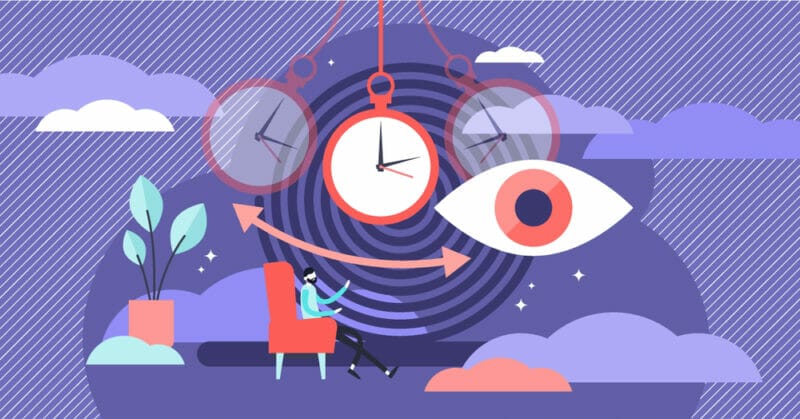Meditation vs Trance: Psychological, Physiological and Spiritual Perspectives
Meditation is a powerful tool that can aid in relaxation, reducing stress, and promoting feelings of confidence and happiness.
The practice has been utilized for thousands of years. While some individuals meditate specifically to achieve a trance-like state, others may inadvertently enter a trance during their meditation practice.
However, it is important to note that there is a difference between the two practices.
This blog post will compare trance and meditation, highlighting the key distinctions between the two.
What Is Meditation?
Meditation is a way to quiet your mind in order to access your higher self. Meditation can help you feel relaxed and happy.
Meditation is a state of being. It’s a way of thinking. It is a way of life. When you meditate, you are in a state of mind that is free of thinking. You are in a state of mind that is free of worrying.
You are in a state of mind that is free of wondering. You are in a state of mind that is free of judging.
Meditation may involve sitting in a quiet place and focusing on your breath.
Some people use their breath to focus, others use a mantra, and some use a combination of both. Some people may even use music or a picture of someone who looks peaceful to aid their focus.
Meditation comes in many forms. Guided meditation is one type of meditation, but there are also transcendental meditations, Kundalini meditations, Vipassana meditations, and Qigong meditations etc.
What Is Trance?
Trance is a state of mind in which a person is not fully aware, but is not fully asleep. It’s a mental state where you are focused on one thing.
When people are hypnotized they go into a trance. A trance is a state of mind where people can’t deal with reality.
When people go into a trance they can’t hear or see anything else around them. But they can still hear and see the things that are happening to them. When people are in a trance they can still move their eyes and hands.
Are They Similar or Different?
Trance is a different state of mind. It is not like meditation. Trance is not intentional. I prefer to think of trance as being like mediumship. People go into a trance when they are mediums.
Meditation can be a way to get to trance. You have to go deep into your mind. To reach that state, you have to dig deep into your emotions. You have to go deep into your emotions. You have to go deep into your soul.
Sometimes people think they are meditating, but they are actually in a trance. People may enter hypnotic trance when they are doing yoga or meditation. Yoga nidra is a type of trance.
However, you don’t need to meditate to be in trance. People who meditate can sometimes experience trance, but you can also be in trance without meditating.
What Are the Main Differences between Meditation and Trance?
In hypnotic trance, you are not yourself. You are controlled by another person. In meditation, you are still yourself. You are not controlled by another person.
To experience meditation at its best, you must be mindful. If you are unconscious in meditation, then you aren’t meditating.
Trance is the opposite of mindfulness. When you are in a trance you are not aware of what is going on around you.
It’s like your brain is on autopilot. You are in your own head, and you are not paying attention.
You might be thinking about something that is happening, or you might be thinking about something that happened a long time ago. You might be thinking about a story you read. You might be thinking about a movie you saw.
In order to get “out” of a trance state, you have to become more mindful.
When you meditate, you are allowing your unconscious mind to take over. Your unconscious mind knows how to meditate already because it is the natural state of the unconscious mind.
In meditation, the challenge is to still your conscious mind so your unconscious mind can take charge.
Hypnosis is when you are in a trance. You can be hypnotized by someone else, or you can do it to yourself. It’s when you are in a trance that you can be influenced by other people.
In self-hypnosis, you repeat an idea over and over again. So you repeat that idea and you get more and more excited about it.
Hypnosis is a state of mind produced by suggestion. When you are hypnotized, you feel as if you are in a dream.
It gives rise to emotional development. Not giving a chance to reason, to the intellectual aspect of your personality, it makes you dull.
Self-hypnotized individuals are not able to think for themselves. They are not able to use critical thinking skills or critical analysis. They are more open to suggestions.
On the other hand, transcendental meditation is a state of consciousness that is different from the other states of consciousness.
It is a special state of consciousness that most people don’t experience. It is different from the other states of consciousness because it is the only state that doesn’t involve any mental activity.
It is a state of consciousness that is awake and aware without any mental activity.
You are not thinking about your problems, you are not thinking about your work, you are not thinking about your family, you are not thinking about your friends, you are not thinking about your vacation, you are not thinking about anything.
Your mind is totally empty. You are just feeling your own self. You are feeling your own existence. You are feeling your own consciousness.
Meditation is totally different from hypnosis. Hypnosis is a technique to make you unconscious. Meditation is a technique to make you alert.
Mindful meditation is a way to be aware of everything around you.
However, you can never be 100% mindful of everything around you because your mind takes in so many things at once.
Mindfulness is different from trance because you can never be fully mindful. Mindfulness is like a scale. You can try to be more mindful, and you can try to be less mindful.
The deepest state of meditation is where you are not thinking about anything. This is called ‘samadhi’.
What Meditation Is All About
I’ve been practicing mindfulness meditation for quite a few years now and I still don’t always get it right.
Sometimes I get impatient and think that I should just get it right already, but I have learned that it doesn’t work that way. You just have to keep practicing and practicing and just be patient. It will come to you.
When I was a kid, I used to play the bamboo flute. I was so bad at it that I wanted to quit. I didn’t get any better and I got frustrated.
But my mom told me to just keep practicing and I would get better. I didn’t believe her and I quit. Years later I tried again and I was terrible. I didn’t want to keep practicing, but I did. I practiced more and I got better.
Although I still make mistakes when I play the flute, I don’t quit anymore. I didn’t become a professional flutist, but I became a much better flute player than I ever was when I was a kid.
It is important to stay patient. You will learn to do it, but it just takes time.
A lot of people have trouble meditating. One of the main reasons is that they are trying to focus on something, but the mind is just wandering around.
It’s important to be aware of the distinction between attention and awareness. Attention is like what you are looking at, like a picture in a frame. Awareness is what you’re seeing that you’re not looking at, like the frame around the picture.
So you can be aware of your thoughts, but you don’t have to focus on them. You can just let them come and go, and be aware of them.
The best thing to focus on when you are meditating is not the thing you can see, but the thing you can see that you are not looking at.
For example, if you are looking at a tree, don’t focus on the tree, but focus on the space around the tree. Or if you are looking at the sky, focus on the space around the sky.
Also, you can start by paying attention to your environment. You can do this by listening to the sounds around you.
For example, if you are in a room, you can hear the sounds of the room and you can hear the sounds outside the room. If you’re in a place that’s really quiet, you can open a window and listen to the sounds outside.
You can also listen to the sounds inside your body. You can listen to your heartbeat, your breathing, and the sounds that your body makes when it moves.
When you meditate, watch the breath. If your attention moves to the objects in the environment, notice that. When you notice that, bring it back to the breath.
There are many forms of meditation. Some people meditate by sitting in a special place.
Some people meditate by doing a special breathing technique. Some people meditate by repeating a word or phrase over and over again.
Basic meditation is easy and effective. The first step is to find a quiet place where you won’t be disturbed. You can sit in a chair or lie on a bed. It’s best to sit with your back straight, but you can also lie down.
You can sit on the floor with your legs crossed, or in a chair with your feet on the ground. You breathe through your abdomen and then you can focus on your third eye chakra. The third eye chakra is the area between your eyebrows.
The next step is to relax. You can close your eyes or leave them open.
Basic meditation is about focusing your attention on one thing and letting go of everything else. It is about being aware of your surroundings, but without letting your mind wander.
Basic meditation is about focusing your attention on one thing and letting go of everything else. It is about being aware of your surroundings, but without letting your mind wander.
Basic meditation is about being in the present moment.
There are different levels of meditation. Some people can sit and meditate for hours and hours and they don’t even move. Sometimes they even fall asleep in that position. Others get up and walk around between meditation sessions.
The goal is to increase tranquility in your mind. Tranquility is a kind of peace. When you are tranquil, you feel peaceful.
You are also trying to improve your concentration. Concentration is the ability to focus on one thing.
The challenge of meditation is to relax and be aware of the object and the body at the same time. It takes dedication and practice.
You have to keep trying and practicing to get better. When you start, it may be difficult, but after you get the hang of it, it will be much easier.
The ego is the sense of ‘I’ that separates you from the rest of the universe. It’s the sense of being a separate person. The ego is what thinks of itself as ‘me’ or ‘I’.
It’s the part of you that thinks of itself as a separate person. In meditation, it’s possible to get into a state where your thoughts stop, but your awareness of the meditation object is still there.
It’s tempting to say that in this state you’ve ‘lost your ego’ or ‘died to the ego’.
Meditation can be hard because the mind is very busy and it is hard to keep your mind focused on one thing.
During meditation you may feel like your body is not moving or doing anything. This is because your body is in a state of suspended animation.
The life force has withdrawn into the higher centers and your body is just not moving.
When the body is in this state, you are still completely aware of your body. You know that my body is still there, but you can’t feel it. There’s something trance-like about this.
When you meditate you can rise above all types of bhava and reach “samadhi”. It is a state where you have no tension. It is a state where you have no confusion.
In simple words, bhava samadhi is like giving a child a lollipop to make it go to school. Giving a child a lollipop is like giving a person the experience of bhava samadhi to make them start meditating.
It is a way to get you to meditate. You have to understand that it is a lollipop to get you to meditate. It is not the real thing.
You have to understand that you have to go to the spiritual school and practice meditation to get the “real thing”.
Psychological Difference Between Trance and Meditation
Both trance and meditation have their psychological processes like chemical and electrical signals that occur in our brains. You need to understand them to have a clear picture of their difference.
Trance and Cognition
Alterations occur in our cognition when we are in a state of trance. We completely forget about the passage of time and start evaluating our subconscious. This practice is healthy in terms of personal development by letting go of all the negative feelings and destructive thoughts.
Meditation and Cognition
In meditation, we experience different physical alterations in brain structure. Here, we keep the focus on the current moment with high alertness. How we respond to a particular stimuli is defined in meditation. Some studies advocate the positive role of meditation in improving certain cognition aspects like better sustained attention and memory.
Trance and Meditation from a Physiological Perspective
Along with psychological changes, trance, and meditation, both have their physiological alteration.
In trance, our brain experiences higher alpha and theta brainwaves which results in passive attention and deep relaxation. With inward focus, our connection to the unconscious mind is attainable with this brain activity.
On the other hand, when practicing meditation, our brain’s areas are activated which are related to alertness and self-recognition. We gain control of our thinking and behavior as the prefrontal cortex of the brain experiences higher activity. This way, our decision-making power gets better and we are capable of controlling stressful thoughts.
Trance and Meditation from a Spiritual Perspective
Both trance and meditation have deep roots in various religions of the world and you can find them in history for self-development or spiritual improvement. Trance is practiced in Tibetan, Buddhism, etc. as a door to connect with the inner soul. Likewise, ecstatic trance is practiced by charismatic Christians.
Likewise, various types of meditation are common in Buddhis where the core purpose is to have enlightenment with alertness. Almost all major religions of the world like Judaism, Christianity, Islam, etc follow specific or different meditation practices. It is used as a path to make a connection with God or the creator.
How Can You Get into Trance?
Sometimes you can get in a trance-like state when you close your eyes and concentrate on something. It is a natural thing to do.
When you are in a trance you are not thinking about anything else, you are just thinking about that one thing. You can focus on a sound, like a drum beat or a song, or you can focus on a feeling, like the feeling of the wind blowing on your face.
You can focus on a thought, like the thought of a memory or a dream. You can focus on a physical sensation, like the feeling of your hands touching each other or the feeling of your body sitting in a chair.
Trance is a way of devotion. You have to surrender and accept things easier in trance.
Hypnotists use trance to help people deal with things in their life.
Self-hypnosis is a process where you make yourself feel good. You block out the thinking part of your brain, and you just feel good.
So you feel good and you feel happy, because you are not thinking and your brain is not thinking. You are just feeling good.
Levels of Consciousness in Trance
For spiritual development, how deep do I need to go in the trance? To get the answer to this question you need to clear your mind about the stages or levels of trance. Let’s see them one by one:
Very Light Trance
At this stage, you start analyzing your inner world. Your senses are focused on your thoughts and feelings and less on the surroundings. Meditation practices that are based on mindfulness allow a person to go into a very light trance.
Light Trance
This is the beginning of the daydreaming phase where you forget about the surroundings and are deeply absorbed in any activity. You will feel a mild control over the mind and the energy at this level. Here, the journey towards connecting yourself with spirit begins.
Flow State Trance
This phase is between light and deep trance where a person loses consciousness toward the surroundings. You become unaware of the place where you are. You have complete focus on the activity and forget about why you are doing it and how much time you are spending on it.
Deep Trance
Here, your muscles feel relaxed and your breathing gets slow. You can resemble this state with the phase you experience just before sleep. Our mind stops thinking rationally and we become unaware of our surroundings, their visuals and sounds. Here, is the time you start unfolding your unconscious mind.
Very Deep Trance
Here you completely lose your consciousness and you relate this state with sleep or coma where you feel no pain/
Light, flow state, and deep trance are the most suitable levels that help individuals nurture the spirit and let go of negative thoughts for better mental health.
Getting into Trance by Meditating
Some people can meditate and go into a trance. Other people can’t. There are certain states of mind that are called jhanas. Sometimes people enter these states of mind while meditating.
When they go into these states, their metabolic signs slow down and they become less sensitive to things around them.
Personal Development with Trance and Meditation
If we talk about the benefits of trance or meditation, then both practices are equally important in personal development. With access to your unconscious mind through trance, you can get rid of unresolved traumas that are hindering your progress or self-development process. You can store positive things in the irrational mind to improve your sense of well-being.
While meditation aids in smoothing the path towards self-development with alertness and mindfulness. It helps make you focus on the present task and ignore all the disturbing thoughts or stimuli. You can exert your energy on your work solely with regular meditation. Your mind also feels fresh with a reduced level of stress which also results in better mental health.
What Are the Benefits of Meditation?
Meditation is a way to relax your mind. It’s a way to get to know yourself better. You often do it by closing your eyes. You can do it for as long as you want. You can do it every day.
It is a state where you have no anger. It is a state where you have no jealousy. It is a state where you have no ego. It is a state where you have no pride.
It is a state where you have no arrogance. It is a state where you have no attachment. It is a state where you have no possessiveness.
What Are the Benefits of Trance?
Hypnotic trance is a healing state. This is a state that can help people feel relaxed and happy. I think it is good to be in a trance sometimes. It helps me.
Hypnosis is a way to make yourself feel like you are in a different world. It is a way to make yourself feel like you are in a different place. It is a way to make yourself feel like you are in a different time.
Frequently Asked Questions
Q: Are meditation and trance both beneficial?
Yes, both meditation and trance have positive effects on the human body and mind. Trance helps us understand our unconscious mind and lets us experience a deep relaxed state. Moreover, meditation assists in having more contractions and makes us feel happy with better mental and physical health.
Q: What changes our mind feel during trance?
Our mind goes through different changes during the trance. It lets the mind go of its thoughts, making its attention to the surroundings nill. This state allows us to access our unconsciousness and understand its hidden folds.
Q: What does a person look like during the trance?
In a trance, a person has an empty face without any expressions or specific eye movement. Normal body movements like feet or hand’s slight movements are absent.
Q: How does trance assist spiritual and psychological improvements?
Our mind acts as a barrier in the communication path towards the unconscious mind. With the trance, you can resolve this hurdle by making your active mind sleep to have a deep transformation.
Q: Why do we need to unfold our unconscious mind?
For spiritual and psychological development, we need to unfold our unconscious mind as our feelings, thoughts, or unresolved painful moments are hidden there. In a trance, a person bypasses the rational mind to make a connection with the irrational mind.




![Backflow Incense Cones Not Working [5 Troubleshooting Steps]](https://ev6e9u5gai4.exactdn.com/wp-content/uploads/2022/05/Backflow-Incense-Cones-Not-Working-Final-768x512.jpg?strip=all&lossy=1&ssl=1)


